Exploration and Prediction of the Elderly Travel Behavior Based on a Novel GR-GA-BP Hybrid Model
Abstract
:1. Introduction
2. Literature Review
3. Study Sites and Data Collection
4. Model Framework
4.1. GR-GA-BP Hybrid Model
4.2. Grey Correlation Degree (GR) Module
- (1)
- Determining the analysis sequence
- (2)
- Dimensionless and standardization of reference and comparison sequence
- (3)
- Calculating relative coefficient
- (4)
- Calculating correlation coefficient
4.3. Back Propagation (BP) Neural Network Module
- (1)
- Forward information transfer algorithm.
- (2)
- Error backpropagation algorithm
4.4. Genetic Algorithm (GA) Module
4.5. Cross-Validation
5. Experimental Results and Discussions
5.1. Prediction Experiment of Travel Characteristics
5.1.1. Prediction Analysis of Times of Weekly Trips
5.1.2. Predicted Round-Trip Travel Time
6. Conclusions
Author Contributions
Funding
Institutional Review Board Statement
Informed Consent Statement
Data Availability Statement
Conflicts of Interest
References
- Böcker, L.; van Amen, P.; Helbich, M. Elderly travel frequencies and transport mode choices in Greater Rotterdam, the Netherlands. Transportation 2017, 44, 831–852. [Google Scholar] [CrossRef] [Green Version]
- Chan, H.Y.; Xu, Y.; Chen, A.; Liu, X. Impacts of the walking environment on mode and departure time shifts in response to travel time change: Case study in the multi-layered Hong Kong metropolis. Travel Behav. Soc. 2022, 28, 288–299. [Google Scholar] [CrossRef]
- Chen, W.H. Exploring Travel Characteristics and Factors Affecting the Degree of Willingness of Seniors in Taiwan to Use an Alternative Service Bus. Transp. Res. Rec. 2010, 2182, 71–78. [Google Scholar] [CrossRef]
- Dargay, J.M.; Clark, S. The determinants of long distance travel in Great Britain. Transp. Res. Part A Policy Pract. 2012, 46, 576–587. [Google Scholar] [CrossRef]
- Dong, R.; Tianyi, S.; Han, G.; Han, W. The Research on Sensitivity of Chinese Urban Elderly Travel Characteristic Parameters. Procedia Eng. 2016, 137, 442–451. [Google Scholar] [CrossRef] [Green Version]
- Du, M.; Cheng, L.; Li, X.; Yang, J. Factors affecting the travel mode choice of the urban elderly in healthcare activity: Comparison between core area and suburban area. Sustain. Cities Soc. 2020, 52, 101868. [Google Scholar] [CrossRef]
- Fang, S.; Yao, X.; Zhang, J.; Han, M. Grey Correlation Analysis on Travel Modes and their Influence Factors. Procedia Eng. 2017, 174, 347–352. [Google Scholar] [CrossRef]
- Schwarzlose, A.A.; Mjelde, J.W.; Dudensing, R.M.; Jin, Y.; Cherrington, L.K.; Chen, J. Willingness to pay for public transportation options for improving the quality of life of the rural elderly. Transp. Res. Part A Policy Pract. 2014, 61, 1–14. [Google Scholar] [CrossRef]
- Lachapelle, U.; Cloutier, M.S. On the complexity of finishing a crossing on time: Elderly pedestrians, timing and cycling infrastructure. Transp. Res. Part A Policy Pract. 2017, 96, 54–63. [Google Scholar] [CrossRef]
- LeCun, Y.; Bottou, L.; Bengio, Y.; Haffner, P. Gradient-based learning applied to document recognition. Proc. IEEE 1988, 86, 2278–2324. [Google Scholar] [CrossRef]
- Lee, D.; Derrible, S.; Pereira, F.C. Comparison of Four Types of Artificial Neural Network and a Multinomial Logit Model for Travel Mode Choice Modeling. Transp. Res. Rec. 2018, 2672, 101–112. [Google Scholar] [CrossRef] [Green Version]
- Lee, H.; Choo, S.; Kim, J. Analyzing the Characteristics of Trip Chaining Activities of the Elderly in Seoul Metropolitan Area. J. Korea Inst. Intell. Transp. Syst. 2014, 13, 68–79. [Google Scholar] [CrossRef] [Green Version]
- Lee, K.S.; Eom, J.K.; Lee, J.; Ko, S. Analysis of the Activity and Travel Patterns of the Elderly Using Mobile Phone-Based Hourly Locational Trajectory Data: Case Study of Gangnam, Korea. Sustainability 2021, 13, 3025. [Google Scholar] [CrossRef]
- Lee, M.-G.; Yu, K.-M. Dynamic Path Planning Based on an Improved Ant Colony Optimization with Genetic Algorithm. In Proceedings of the 2018 IEEE Asia-Pacific Conference on Antennas and Propagation (APCAP), Auckland, New Zealand, 5–8 August 2018; pp. 1–2. [Google Scholar] [CrossRef]
- Liu, C.; Bardaka, E.; Palakurthy, R.; Tung, L.W. Analysis of travel characteristics and access mode choice of elderly urban rail riders in Denver, Colorado. Travel Behav. Soc. 2020, 19, 194–206. [Google Scholar] [CrossRef]
- Liu, S.; Yamamoto, T.; Yao, E.; Nakamura, T. Examining public transport usage by older adults with smart card data: A longitudinal study in Japan. J. Transp. Geogr. 2021, 93, 103046. [Google Scholar] [CrossRef]
- Liu, W.; Lu, H.; Sun, Z.; Liu, J. Elderly’s Travel Patterns and Trends: The Empirical Analysis of Beijing. Sustainability 2017, 9, 981. [Google Scholar] [CrossRef] [Green Version]
- Ning, J.; Lyu, T.; Wang, Y. Exploring the Built Environment Factors in the Metro That Influence the Ridership and the Market Share of the Elderly and Students. J. Adv. Transp. 2021, 2021, 9966794. [Google Scholar] [CrossRef]
- Sallehuddin, R.; Shamsuddin, S.M.; Hashim, S.Z. Application of Grey Relational Analysis for Multivariate Time Series. In Proceedings of the 2008 Eighth International Conference on Intelligent Systems Design and Applications, Kaohsuing, Taiwan, 26–28 November 2008. [Google Scholar] [CrossRef]
- Schmöcker, J.D.; Quddus, M.A.; Noland, R.B.; Bell, M.G. Estimating Trip Generation of Elderly and Disabled People: Analysis of London Data. Transp. Res. Rec. 2005, 1924, 9–18. [Google Scholar] [CrossRef]
- Sen, Z.; Ke, Z.; Xiaoyang, L.; Jian, Z.; Yan, L.; Lian, Z. Characterisation of elderly daily travel behaviour in Tianjin using a space–time cube. Environ. Plan. B Urban Anal. City Sci. 2021, 49, 603–618. [Google Scholar] [CrossRef]
- Seo, S.E.; Jeong, J.H.; Kim, S.G. Analysis of the Elderly Travel Characteristics and Travel Behavior with Daily Activity Schedules (the Case of Seoul, Korea). J. Korean Soc. Transp. 2006, 24, 89–108. [Google Scholar]
- Shi, Z.; Pun-Cheng, L.S.; Liu, X.; Lai, J.; Tong, C.; Zhang, A.; Zhang, M.; Shi, W. Analysis of the Temporal Characteristics of the Elderly Traveling by Bus Using Smart Card Data. ISPRS Int. J. Geo Inf. 2020, 9, 751. [Google Scholar] [CrossRef]
- Smith, G.C.; Sylvestre, G.M. Determinants of the Travel Behavior of the Suburban Elderly. Growth Chang. 2001, 32, 395–412. [Google Scholar] [CrossRef]
- Stern, S. A disaggregate discrete choice model of transportation demand by elderly and disabled people in rural Virginia. Transp. Res. Part A Policy Pract. 1993, 27, 315–327. [Google Scholar] [CrossRef]
- Szeto, W.Y.; Yang, L.; Wong, R.C.; Li, Y.C.; Wong, S.C. Spatio-temporal travel characteristics of the elderly in an ageing society. Travel Behav. Soc. 2017, 9, 10–20. [Google Scholar] [CrossRef] [Green Version]
- Titheridge, H.; Achuthan, K.; Mackett, R.; Solomon, J. Assessing the extent of transport social exclusion among the elderly. J. Transp. Land Use 2009, 2, 31–48. [Google Scholar] [CrossRef] [Green Version]
- Wang, S.; Li, L.; Ma, W.; Chen, X. Trajectory analysis for on-demand services: A survey focusing on spatial-temporal demand and supply patterns. Transp. Res. Part C Emerg. Technol. 2019, 108, 74–99. [Google Scholar] [CrossRef]
- Yadav, S.; Shukla, S. Analysis of k-Fold Cross-Validation over Hold-Out Validation on Colossal Datasets for Quality Classification. In Proceedings of the 2016 IEEE 6th International Conference on Advanced Computing (IACC), Bhimavaram, India, 27–28 February 2016. [Google Scholar] [CrossRef]

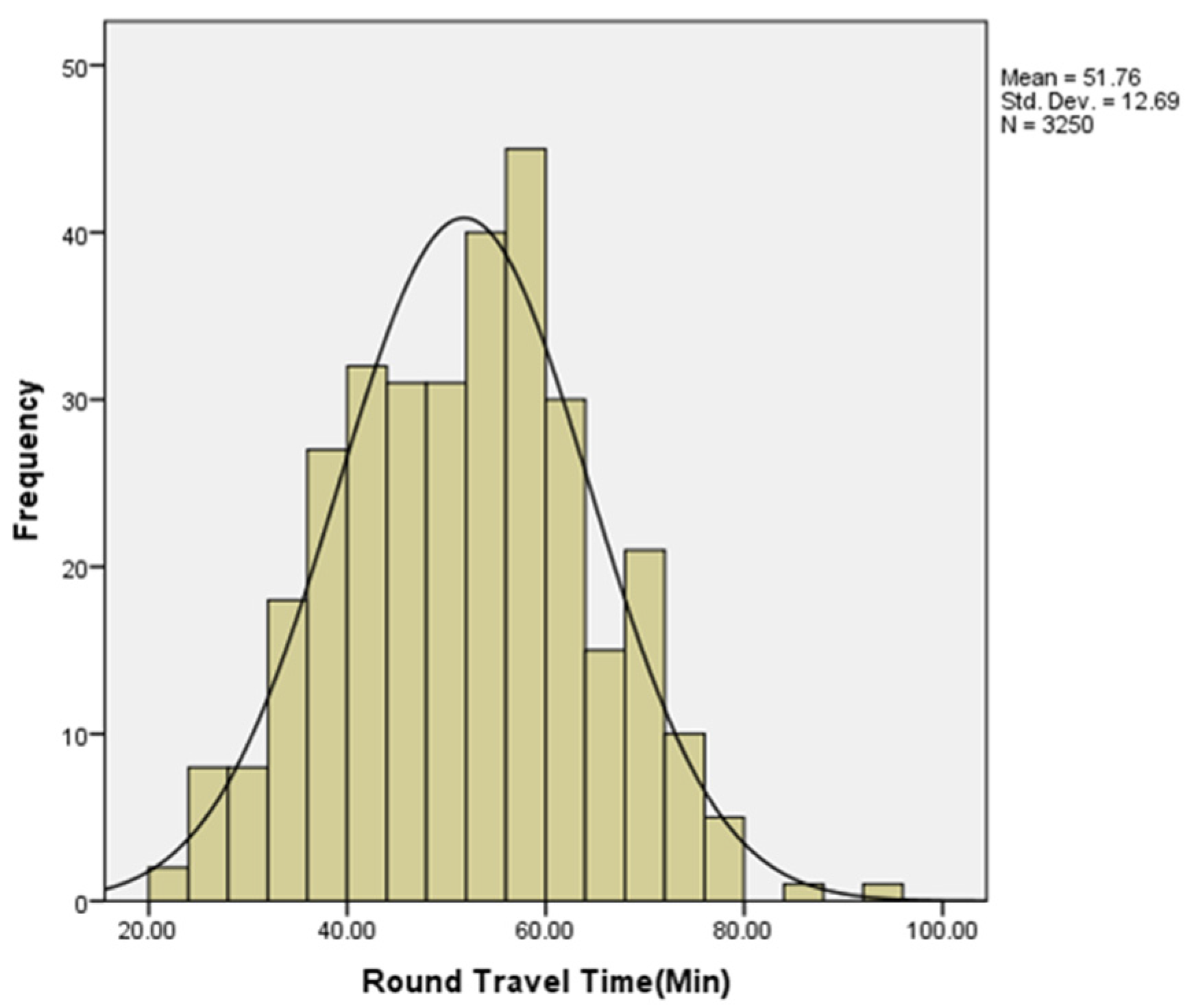
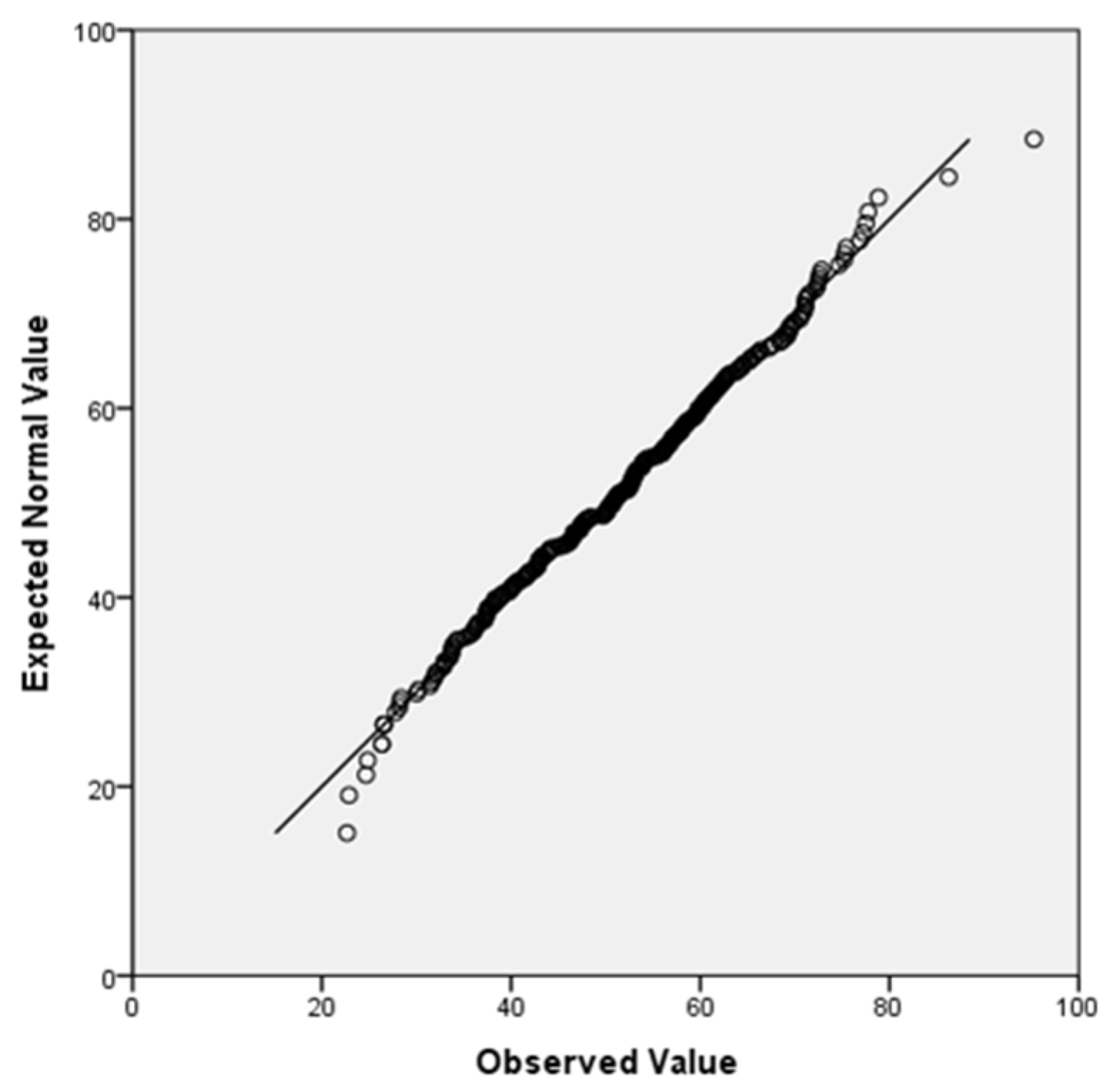



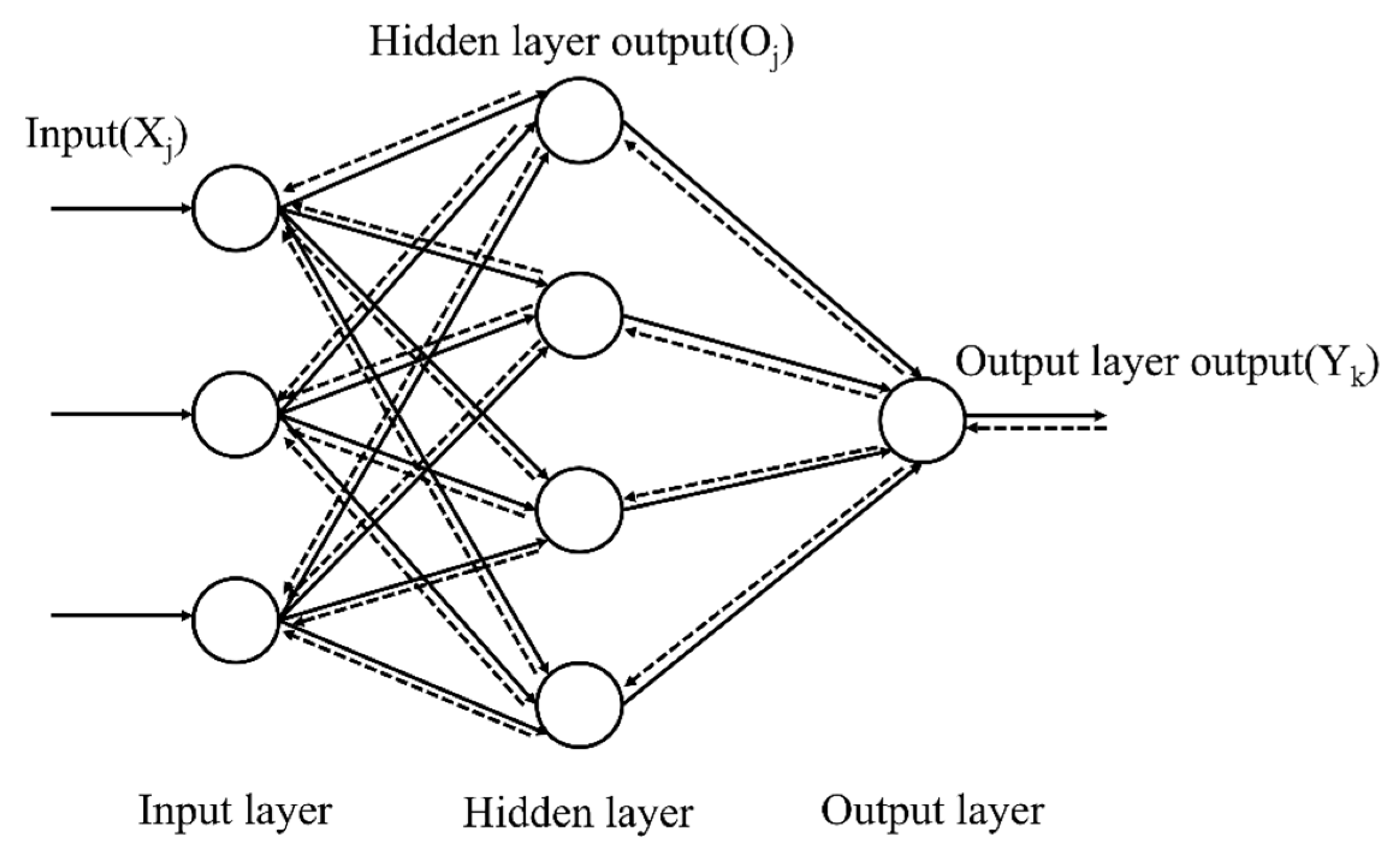
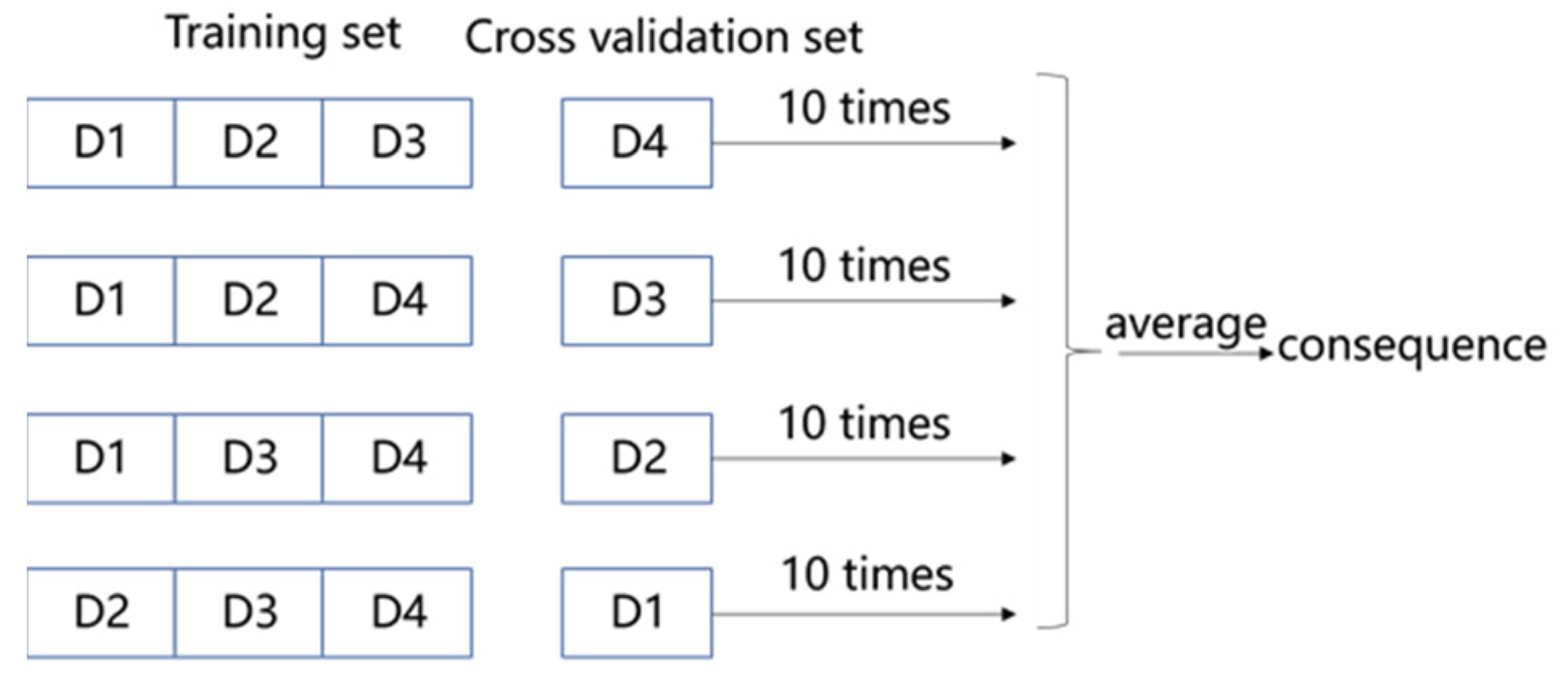
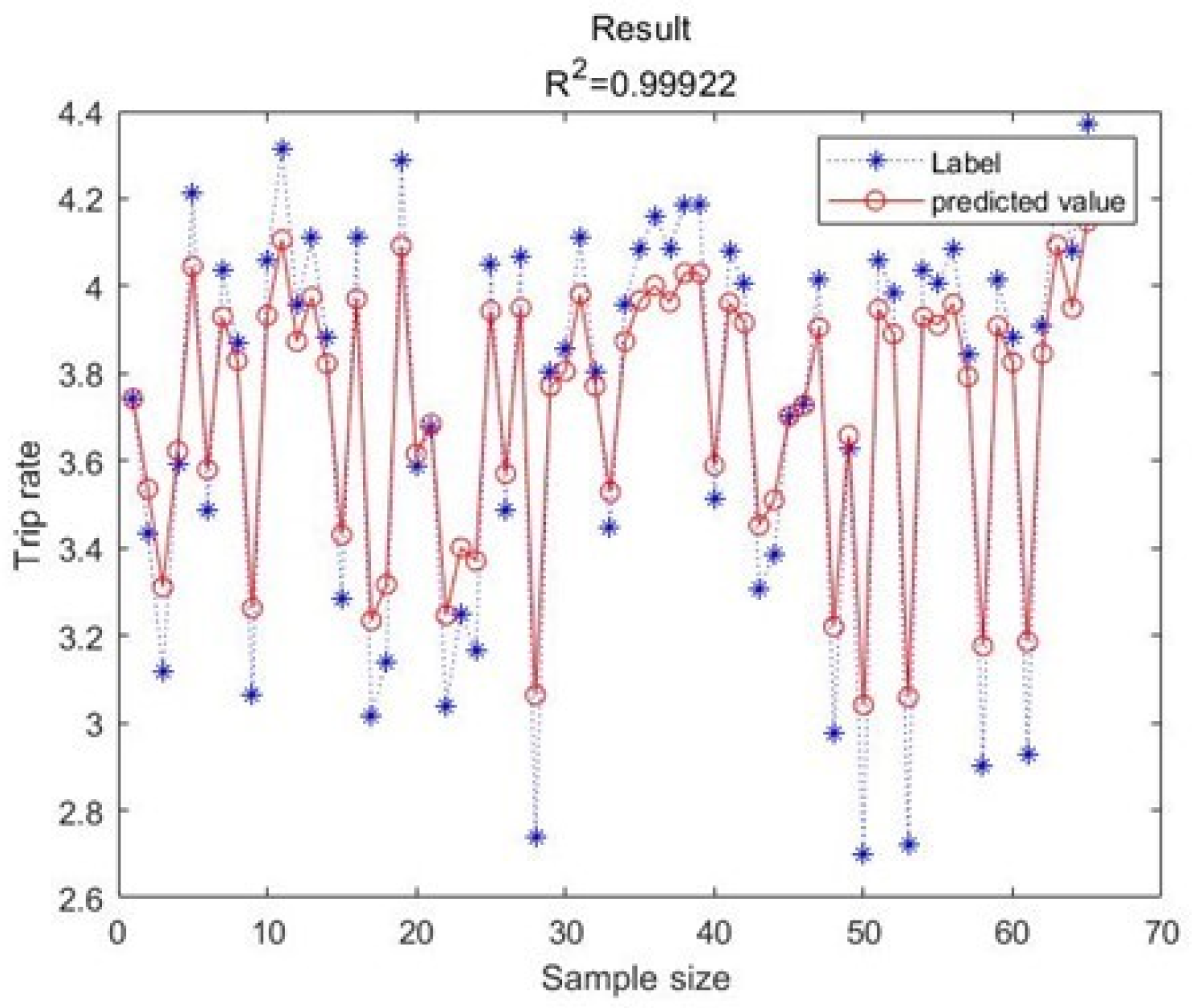



| Attributes | Variable | Value |
|---|---|---|
| Individual | Spouse (x1) | Yes 2, No 1 |
| Gender (x2) | Male, 2; Female,1 | |
| Age (x3) | Take the Discrete Value | |
| Older Singletons (x4) | Yes 2, No 1 | |
| Driver License (x5) | Yes 2, No 1 | |
| Monthly Pass (x6) | Yes 2, No 1 | |
| Family | Have Children (x7) | Yes 2, No 1 |
| Size of Family (x8) | 1 to 6 | |
| Have Car (x9) | Yes 2, No 1 | |
| Have Bike (x10) | Yes 2, No 1 | |
| Have Electric Bike or Tricycle (x11) | Yes 2, No 1 | |
| External Environment | Bus Station (x12) | Yes 2, No 1 |
| Subway Station (x13) | Yes 2, No 1 | |
| Mall (x14) | Yes 2, No 1 | |
| Old Town (x15) | Yes 2, No 1 | |
| Recreational Facilities (x16) | Yes 2, No 1 | |
| Travel Characteristics | Times of Weekly Trips (y1) | Times/day |
| Average Round-Trip Travel Time (y2) | Minute |
| Variable | Times of Weekly Trips (y1) | Average Round-Trip Travel Time (y2) |
|---|---|---|
| Spouse (x1) | 0.802 | 0.829 |
| Gender (x2) | 0.942 | 0.879 |
| Age (x3) | 0.943 | 0.874 |
| Older Singletons (x4) | 0.920 | 0.855 |
| Driver License (x5) | 0.930 | 0.884 |
| Monthly Ticket (x6) | 0.949 | 0.874 |
| Have Children (x7) | 0.946 | 0.882 |
| Size of Family (x8) | 0.618 | 0.623 |
| Have Car (x9) | 0.862 | 0.844 |
| Have Bike (x10) | 0.948 | 0.881 |
| Have Electric Bike or Tricycle (x11) | 0.896 | 0.868 |
| Bus (x12) | 0.960 | 0.885 |
| Subway Station (x13) | 0.954 | 0.881 |
| Mall (x14) | 0.95 | 0.876 |
| Old Town (x15) | 0.955 | 0.882 |
| Recreational Facilities (x16) | 0.954 | 0.884 |
| Abirritate | Times of Weekly Trips | Average Round-Trip Travel Time |
|---|---|---|
| Constant | ||
| Individual | x2 | x2 |
| x3 | x3 | |
| x4 | x4 | |
| x5 | x5 | |
| x6 | x6 | |
| Family | x7 | x7 |
| x10 | x10 | |
| x11 | ||
| External Environment | x12 | x12 |
| x13 | x13 | |
| x14 | x14 | |
| x15 | x15 | |
| x16 | x16 |
| Iteration Times | Population Size | Crossover Probability | Mutation Probability | Learning Rate |
|---|---|---|---|---|
| 100 | 200 | 0.85 | 0.01 | 0.001 |
| Times of Weekly Trips | LR | BP | GA-BP | GR-BP | GR-GA-BP |
|---|---|---|---|---|---|
| MRE | 47.81% | 32.5% | 27.27% | 38.02% | 23.12% |
| MSE | 1.1842 | 0.77923 | 0.5844 | 0.9055 | 0.5637 |
| time | 1 × 10−7 | 4 × 10−7 | 3 × 10−6 | 4 × 10−7 | 7 × 10−6 |
| Iteration Times | Population Size | Crossover Probability | Mutation Probability | Learning Rate |
|---|---|---|---|---|
| 150 | 500 | 0.3 | 0.01 | 0.01 |
| Round-Trip Travel Time Prediction | LR | BP | GA-BP | GR-BP | GR-GA-BP |
|---|---|---|---|---|---|
| MRE | 23.31% | 15.3% | 13.27% | 8.29% | 7.13% |
| MSE | 36.53 | 23.45 | 20.44 | 18.03 | 17.53 |
| time | 2 × 10−7 | 2 × 10−7 | 3 × 10−6 | 2 × 10−7 | 3 × 10−6 |
Publisher’s Note: MDPI stays neutral with regard to jurisdictional claims in published maps and institutional affiliations. |
© 2022 by the authors. Licensee MDPI, Basel, Switzerland. This article is an open access article distributed under the terms and conditions of the Creative Commons Attribution (CC BY) license (https://creativecommons.org/licenses/by/4.0/).
Share and Cite
Li, Z.; Wang, Z.; Wen, Y.; Zhao, L. Exploration and Prediction of the Elderly Travel Behavior Based on a Novel GR-GA-BP Hybrid Model. Sustainability 2022, 14, 13448. https://doi.org/10.3390/su142013448
Li Z, Wang Z, Wen Y, Zhao L. Exploration and Prediction of the Elderly Travel Behavior Based on a Novel GR-GA-BP Hybrid Model. Sustainability. 2022; 14(20):13448. https://doi.org/10.3390/su142013448
Chicago/Turabian StyleLi, Zhihong, Zinan Wang, Yanjie Wen, and Li Zhao. 2022. "Exploration and Prediction of the Elderly Travel Behavior Based on a Novel GR-GA-BP Hybrid Model" Sustainability 14, no. 20: 13448. https://doi.org/10.3390/su142013448





